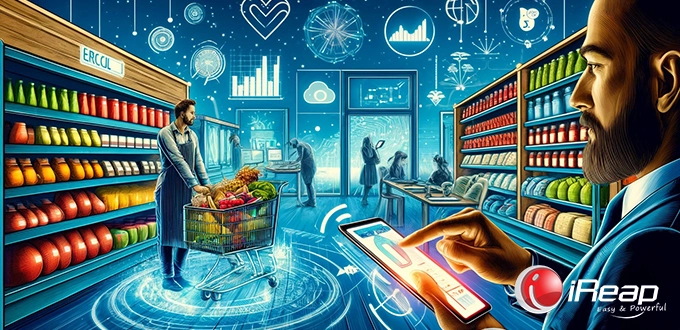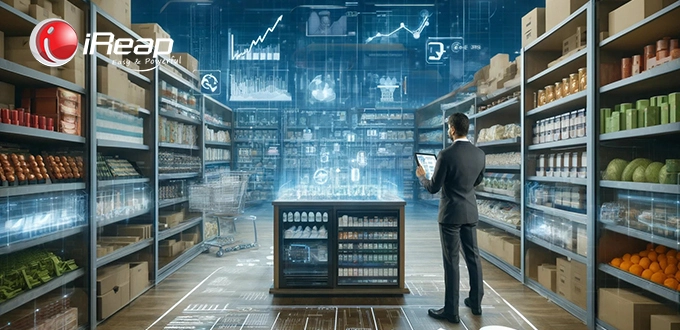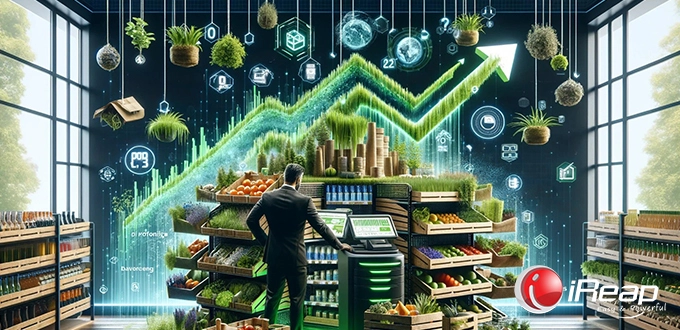
In the continually evolving digital era, proprietors of grocery stores are confronted with increasingly intricate challenges in managing their inventory. With unpredictable demand fluctuations, diverse types of goods, and intense competition, effective stock management becomes paramount in sustaining business success.
Traditionally, inventory management in grocery stores has often been conducted manually, which can be time-consuming and susceptible to errors.
Shop owners frequently find themselves reliant on manual calculations and demand estimations, which can result in inaccurate stock assessments and unnecessary revenue losses.
However, with technological advancements and the emergence of digital solutions, grocery store proprietors now have access to tools that can assist them in tackling these challenges more efficiently.
One increasingly popular solution is the iReap POS application, specifically designed to aid small and medium-sized business owners in managing inventory more effectively.
Challenges in Grocery Store Inventory Management
Grocery store owners often encounter a myriad of complex challenges in managing their stock. Here are some key challenges they face:
1. Variability in Product Demand
The demand for specific items in grocery stores can vary significantly, depending on factors such as season, weather, and local events.
Accurately estimating demand becomes challenging, and errors in estimation can lead to stock shortages or unsold inventory accumulation.
2. Difficulties in Manual Inventory Monitoring
Traditionally, inventory monitoring in grocery stores is often done manually. This involves periodic item counting and manual recording of stock changes.
This process is not only time-consuming but also prone to human errors.
3. Risk of Revenue Loss Due to Poorly Managed Stock
Stock shortages or excess inventory can negatively impact grocery store revenue.
Stock shortages can result in lost sales and disappointed customers, while excess inventory can erode profits as items expire or deteriorate over time.
Understanding these various challenges, it is essential for grocery store owners to seek solutions that can help them overcome inventory management hurdles and enhance their operational efficiency.

Benefits of Digitization in Inventory Management
While grocery store owners face various challenges in managing their stock, digitization solutions offer several significant benefits. Here are some key benefits of digitization in grocery store inventory management:
1. Real-time Stock Monitoring
With digital solutions, grocery store owners can monitor inventory in real-time through digital platforms. This allows them to quickly assess remaining stock levels, identify items needing replenishment, and respond to demand changes more swiftly and accurately.
2. Demand and Inventory Prediction
Digital solutions often come with advanced data analysis features that enable grocery store owners to predict future demand and inventory.
By leveraging historical data and sales trends, they can make smarter decisions in inventory planning and management.
3. Reduction of Revenue Loss Risk
By monitoring stock in real-time and predicting demand more accurately, digital solutions can help reduce the risk of revenue loss due to stock shortages or excess inventory.
This helps grocery store owners maintain profitability and enhance customer satisfaction.
4. Improved Operational Efficiency
By automating many stock management processes, digital solutions can help improve operational efficiency in grocery stores.
This allows store owners to focus on other aspects of their business and allocate resources more effectively.
Features of Digital Solutions for Inventory Management
Among the various digital solutions available for grocery store inventory management, one such solution is the iReap POS application. This application is specifically designed to assist small and medium-sized business owners in managing inventory more efficiently.
iReap POS offers several highly useful features in stock management, including automated inventory systems, low stock notifications, as well as transaction history and data analysis.
With automated inventory systems, grocery store owners can easily track their stock in real-time. This allows them to quickly identify items needing replenishment and avoid stock shortages that may disrupt daily operations.
The low stock notification feature also helps grocery store owners remain vigilant about items running low.
By receiving automatic notifications when the stock of a particular item reaches the minimum level, they can promptly take action to reorder the item, ensuring that no customers are disappointed due to stockouts.
Additionally, iReap POS provides comprehensive transaction history and data analysis to help grocery store owners understand customer purchasing patterns, sales trends, and the performance of specific products.
This information can be used to make smarter decisions in inventory planning, adjust pricing strategies, and optimize customer service.

Implementation of Digital Solutions
After understanding the benefits and features of digital solutions such as iReap POS, the next step is to implement this system in your grocery store. Here are the steps you can follow to start digitizing inventory management:
- Evaluate Your Business Needs: First, identify the specific needs of your grocery store and determine how digital solutions can help address the challenges you face in inventory management.
- Choose the Right Solution: After that, research various digital solutions available in the market, including the iReap POS application, and consider features, pricing, and ease of use before making a decision.
- Employee Training: Once you’ve chosen the right solution, make sure to provide training to your employees on how to use the system. Ensure they understand how to use the application correctly to maximize its benefits.
- Data Migration: If you already have inventory data stored in another format, make sure to migrate the data properly into the new system so you can start with accurate data.
- Testing and Evaluation: Before fully adopting digital solutions in day-to-day operations, conduct testing first to ensure that the system functions properly. Furthermore, continue to evaluate periodically to ensure that the system remains aligned with your business needs.
By following these steps, you can embark on the journey of digitizing inventory management in your grocery store. Remember that change may take time and patience, but the long-term benefits of improved efficiency will be worth your efforts.
Conclusion
Through this article, we have explored various challenges in grocery store inventory management, the benefits of digitization in addressing these challenges, and the features of digital solutions such as iReap POS.
We have also provided implementation steps and case studies of grocery stores that have successfully adopted digital solutions.
By understanding the importance of digital solutions in inventory management, we encourage grocery store owners to consider digitization as a strategic step to enhance their business performance.
With the right digital solution adoption and a commitment to continuously improving their operations, grocery store owners can achieve greater success in an increasingly competitive market.
Let us take steps together to adopt digital solutions in grocery store inventory management to achieve efficiency, optimize customer service, and enhance business profitability.



